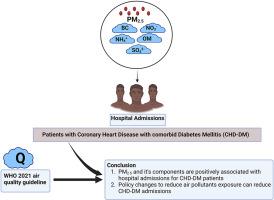中国北京地区短期暴露于环境PM2.5及其成分与冠心病和合并症糖尿病患者住院的关系
IF 7.7
2区 环境科学与生态学
Q1 ENVIRONMENTAL SCIENCES
引用次数: 0
摘要
现有的研究主要是单独调查各种空气污染物与冠心病或糖尿病风险之间的关系。然而,PM2.5及其组分在冠心病合并糖尿病(CHD-DM)患者中的意义和影响尚不清楚。患者数据来源于2014年1月1日至2018年12月31日期间的北京市卫生健康委员会信息中心。我们利用广义加性模型(GAM)分析冠心病-糖尿病患者每日住院与PM2.5暴露之间的关系。入院人数作为计数数据,用对数联系函数与冠心病-糖尿病总人数相抵消。包括平滑函数,以考虑中国和世界卫生组织空气质量指南中使用的时间趋势和气象因素的非线性影响。在北京,记录显示有215,267名冠心病患者入院。空气动力学直径≤2.5 μm的颗粒物(PM2.5)每增加10 μg/m3,冠心病-糖尿病患者入院率增加0.62% (95%CI: 0.49 ~ 0.76)。PM2.5成分:CHD-DM患者入院时,每10 μg/m3 SO42-增加2.31% (95%CI: 1.51 ~ 3.11), NO3-增加3.35% (95%CI: 2.47 ~ 4.23), NH4+增加4.37% (95%CI: 2.99 ~ 5.77), OM增加5.36% (95%CI: 4.19 ~ 6.55), BC增加36.51% (95%CI: 28.09 ~ 45.47)。根据世界卫生组织2021年空气质量指南,我们的估计表明,PM2.5浓度的降低可以避免约2.62% (95%CI: 2.04%至3.2%)的住院率,相当于5632例(95%CI: 4397至6879)冠心病糖尿病患者。暴露于PM2.5及其成分的冠心病-糖尿病患者入院风险增加。此外,在所有PM2.5成分中,BC可能是PM2.5与冠心病-糖尿病患者住院率之间关系的最重要贡献者。本文章由计算机程序翻译,如有差异,请以英文原文为准。

Association between short-term exposure to ambient PM2.5 and its components with hospital admissions for patients with coronary heart disease and comorbid diabetes mellitus in Beijing, China
Existing researches had primarily investigated the associations between various air pollutants and the risk of coronary heart disease (CHD) or diabetes mellitus (DM) separately. However, the significance and effects of PM2.5 and its components in patients with CHD and comorbid DM (CHD-DM) remain unclear. Patient data was sourced from the Beijing Municipal Health Commission Information Centre between January 1, 2014, and December 31, 2018. We utilized Generalized Additive Models (GAM) to analyze the relationship between daily hospital admissions for CHD-DM patients and PM2.5 exposure. The hospital admissions were treated as count data, offset by the total CHD-DM population, with a logarithmic link function. Smooth functions were included to account for the non-linear effects of time trends and meteorological factors used in both Chinese and WHO air quality guidelines. In Beijing, records show 215,267 hospital admissions for patients with CHD-DM. Every 10 μg/m3 increase of particles with an aerodynamic diameter ≤2.5 μm (PM2.5) corresponded to a 0.62% (95%CI: 0.49 to 0.76) increment for CHD-DM patients' admissions. As for the PM2.5 components: Per 10 μg/m3 increase of SO42− was 2.31% (95%CI: 1.51 to 3.11), NO3− was 3.35% (95%CI: 2.47 to 4.23), for NH4+ the percentage change value was 4.37% (95%CI: 2.99 to 5.77), for OM was 5.36% (95%CI: 4.19 to 6.55), for BC was 36.51% (95%CI: 28.09 to 45.47) increment for CHD-DM patients’ admissions. Based on the WHO 2021 air quality guideline, our estimation suggests that a reduction in PM2.5 concentrations could prevent approximately 2.62% (95%CI: 2.04%–3.2%) hospital admissions, corresponding to 5632 (95%CI: 4397 to 6879) CHD-DM patients, could be avoidable. Patients with CHD-DM who were exposed to PM2.5 and its components had an increased risk of hospital admissions. Furthermore, among all PM2.5 components, BC may be the most significant contributor to the association between PM2.5 and hospital admissions among CHD-DM patients.
求助全文
通过发布文献求助,成功后即可免费获取论文全文。
去求助
来源期刊

Environmental Research
环境科学-公共卫生、环境卫生与职业卫生
CiteScore
12.60
自引率
8.40%
发文量
2480
审稿时长
4.7 months
期刊介绍:
The Environmental Research journal presents a broad range of interdisciplinary research, focused on addressing worldwide environmental concerns and featuring innovative findings. Our publication strives to explore relevant anthropogenic issues across various environmental sectors, showcasing practical applications in real-life settings.
 求助内容:
求助内容: 应助结果提醒方式:
应助结果提醒方式:


